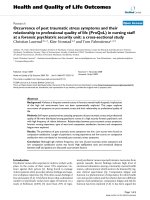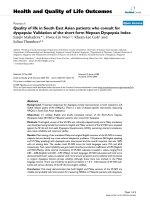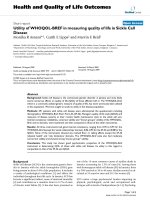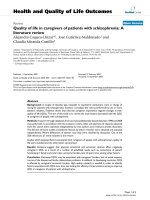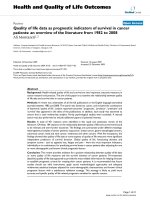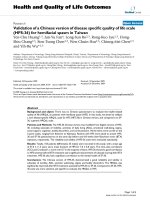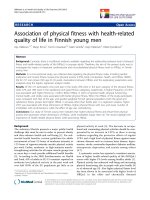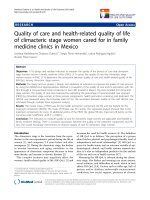báo cáo hóa học:" Quality of life of caregivers with relatives suffering from mental illness in Hong Kong: Roles of caregiver " ppt
Bạn đang xem bản rút gọn của tài liệu. Xem và tải ngay bản đầy đủ của tài liệu tại đây (308.96 KB, 27 trang )
This Provisional PDF corresponds to the article as it appeared upon acceptance. Fully formatted
PDF and full text (HTML) versions will be made available soon.
Quality of life of caregivers with relatives suffering from mental illness in Hong
Kong: Roles of caregiver characteristics, caregiving burdens, and satisfaction
with psychiatric services
Health and Quality of Life Outcomes 2012, 10:15 doi:10.1186/1477-7525-10-15
Daniel Fu Keung Wong ()
Angus Yuk Kit Lam ()
Sau Kam Chan ()
Shuk Fan Chan ()
ISSN 1477-7525
Article type Research
Submission date 10 August 2011
Acceptance date 31 January 2012
Publication date 31 January 2012
Article URL />This peer-reviewed article was published immediately upon acceptance. It can be downloaded,
printed and distributed freely for any purposes (see copyright notice below).
Articles in HQLO are listed in PubMed and archived at PubMed Central.
For information about publishing your research in HQLO or any BioMed Central journal, go to
/>For information about other BioMed Central publications go to
/>Health and Quality of Life
Outcomes
© 2012 Wong et al. ; licensee BioMed Central Ltd.
This is an open access article distributed under the terms of the Creative Commons Attribution License ( />which permits unrestricted use, distribution, and reproduction in any medium, provided the original work is properly cited.
1
Quality of life of caregivers with relatives suffering from mental illness in Hong Kong: Roles
of caregiver characteristics, caregiving burdens, and satisfaction with psychiatric services
Daniel Fu Keung Wong
1
, Angus Yuk Kit Lam
1
, Sau Kam Chan
2
and Shuk Fan Chan
2
1. Applied Social Studies, City University of Hong Kong, Hong Kong SAR
2. Baptist Oi Kwan Social Service, Hong Kong SAR
Email addresses:
DFKW: (corresponding author)
AYKL:
SKC:
SFC:
2
Abstract
Background: The study attempted to explore the quality of life (QoL) of Chinese caregivers with
mentally ill relatives. It also aimed to examine the differential roles of caregiving burdens,
caregiver characteristics, and satisfaction with psychiatric services in caregivers’ QoL.
Methods: 276 caregivers with relatives attending community psychiatric facilities in Hong Kong
were invited to fill out a questionnaire. One sample t-tests were conducted to compare the results
of this study with that of other Chinese populations in Hong Kong, Taiwan, and mainland China.
A hierarchical regression analysis was performed to examine the relative influence of different
factors on caregivers’ QoL.
Results: Our sample of caregivers had significantly lower QoL scores than other Chinese
populations. Results also suggest that Chinese caregivers who had chronic illness, younger in age,
a lower education level, experienced more difficulties in handling negative symptoms, and were
more dissatisfied with mental health services had poorer quality of life. Indeed, caregiver
characteristics displayed a much stronger association with caregivers’ QoL than did caregiving
burdens and satisfaction with psychiatric services.
Conclusions: This study supports the strong association of caregiver characteristics and the QoL of
caregivers and establishes the nature of the relationship between satisfaction with mental health
services and caregiver QoL. Implications for future research and practice are discussed.
Keywords: Quality of Life, Caregivers characteristics, Caregiving Burden, Satisfaction with
psychiatric services, Hong Kong
3
Introduction
Caring for a family member with mental illness can be burdensome. Caregivers may
experience financial burdens, difficulty handling disruptive behavior and fluctuating emotions that
cannot be controlled, a lack of time for personal enjoyment and social engagement, difficulty
handling the lack of motivation found in the mentally ill family member, and financial difficulties
[1, 2]. Evidence of family burdens is also found among caregivers with different ethnic
backgrounds such as Chileans [3], Swedes [4], Germans [5], Hong Kong Chinese [6, 7], and
mainland Chinese [8]. The impact of caring burdens on the psychological wellbeing of caregivers
has also been well documented, the results generally suggesting that caregivers suffer from poor
psychological health and that some of them may even develop mental illness [2, 6].
Although it is commonly acknowledged that caregiving burdens can lead to caregivers with
a relative suffering from mental illness experiencing poor quality of life (QoL) [2], few studies
have explored this relationship empirically. The few studies that have done so found that family
burdens were inversely related to the QoL of caregivers with children suffering from mental health
problems [9], mood disorders [10], and schizophrenia [4]. Similar studies have also been
conducted on caregivers with different ethnic backgrounds, the findings also suggesting that
Sudanese caregivers [11] and Kuwaiti caregivers [12] with greater caregiving burdens have poorer
QoL. A careful review of the literature identified only one English language article concerning
caregivers’ burdens and the QoL of Chinese caregivers with a schizophrenic family member [13].
The results suggest that the best QoL predictors for such Chinese family caregivers are physical
health and household income. However, the study in question is subject to a number of limitations.
Because Chinese caregivers living in different parts of China and the world are exposed to different
sets of societal and contextual factors influencing their caring experiences, the findings generated
by Li et al. may not be applicable to Chinese people living in other parts of China and the world
4
[13]. Second, because the samples considered in their study were taken from three hospitals, the
caregivers who took part in the survey could have been experiencing a higher level of stress due to
their relatives’ hospitalization. Lastly, caregivers who are living with their mentally ill family
members in the community may have different caregiving burden experiences that affect their QoL
in different ways. To the best of our knowledge, no previous study has investigated the caregiving
burdens and QoL of Chinese caregivers in Hong Kong. This study intended to explore the quality
of life of a group of Chinese caregivers whose mentally ill relatives were living in the communities
in Hong Kong; and to examine different factors that might influence caregivers’ quality of life. In
the literature, there are three sets of factors – (1) caregiving situation; (2) caregiver factors; and (3)
environmental factors – that can potentially impact on the QoL of Chinese caregivers with relatives
suffering from mental illness in Hong Kong (See Figure 1).
Caregiving situation
The ‘caregiving situation’ can be defined as variables related to characteristics of the
patient’s illness that impact on the QoL of the caregiver. These factors may include the functional
status of the patient or the caregiver’s perception and evaluation of the care needs of the patient. In
the mental health literature, objective and subjective burdens are commonly defined as caregiving
situations which affect the QoL of caregivers with relatives suffering from mental illness. The
‘objective burden’ may be defined as ‘all those things that the caregiver and/or his or her family
has to do (e.g. helping and supervising), experiences (e.g. disturbed family and/or social relations),
or is not allowed to do (e.g. hobbies and work) as a consequence of caregiving [14]. It also includes
the tasks of handling the emotional needs of the mentally ill relative [2]. On the other hand, the
‘subjective burden’ may be defined as the distress experienced by the caregiver in dealing with the
objective burden [15], potentially including feeling trapped, guilty, shameful, isolated, and
5
emotionally exhausted [15]. Studies in the literature have suggested that Chinese caregivers (i)
experience difficulties managing the negative symptoms presented by relatives with mental illness
and handling positive symptoms [6]; (ii) pay high psychological and social costs when caring for
their relatives [6]; and (iii) have poor mental health outcomes [6, 7]. However, no study has
examined the caregiving burdens and QoL of Chinese caregivers in Hong Kong. In this study,
‘caregiving burdens’ are defined as perceived strains associated with handling positive and
negative symptoms presented by mentally ill relatives and the social and psychological costs borne
when caring for such relatives.
Caregiver factors
According to White et al. [16], caregiver factors are conceptualized as characteristics of the
caregiver – who he/she is (i.e. age, gender, etc.) and his/her personal attributes – that may impact
on the caregiver’s QoL. Sales [2] argued that many studies fail to examine contextual variables –
such as life circumstances and demographic characteristics – that may strongly affect the QoL of
caregivers with family member suffering from mental and other chronic illnesses. These
demographic characteristics may include the socioeconomic status, ethnicity, age, gender, and
family stage and composition of the caregiver. For example, Awadalla et al. [11] found that among
caregivers of Sudanese psychiatric patients, those who were females, parents, less educated, older,
or had poor physical health were associated with poor QoL. In China, Li, Lambert & Lambert [13]
revealed that among caregivers with schizophrenic relatives, those who had higher household
income and better physical health had better QoL. However, because of differences in societal
environments, there is uncertainty as to whether the findings of Li et al.’s study are applicable to
Chinese populations outside mainland China.
6
Environmental factors
Environmental factors include support from family and friends, support from the health care
system, and the availability of and satisfaction with environmental resources [16]. Marsh and
Johnson [17] maintained that there is a need to pay greater attention to the difficulties caregivers
face when dealing with the health care system because caregivers’ efforts can place them under
tremendous strain and potentially impact on their QoL. However, a review of the literature showed
very few empirical studies exploring the impact of environmental factors such as satisfaction with
services on the QoL of caregivers with relatives suffering from mental illness. In this study, we
attempted to examine the relationship such environmental factors have with QoL among caregivers
with relatives suffering from mental illness.
Since previous findings appear to suggest that caregiving burdens are consistently related to
poor mental health and QoL among caregivers, one assumption made in this study was that such
burdens would have the strongest association with the QoL of caregivers. Our study also
hypothesized that caregiver factors and environmental factors are the second and third most
important sets of factors associating with the QoL of caregivers. This prioritization was based on
the findings relating to each such set of factors reflected in the literature.
Objectives
This study aimed at explore the quality of life and caregiving burdens of caregivers with
relatives suffering from mental illness in Hong Kong; and examining the association between
caregiving burdens, caregiver characteristics, satisfaction with mental health services and the QoL
of caregivers.
7
Hypotheses
There were three hypotheses in this study: (1) caregivers with greater caregiving burdens
have poorer quality of life; (2) caregivers with a lower level of satisfaction with mental health
services have poorer quality of life; and (3) ‘caregiving burdens’ had the stronger association with
the QoL of caregivers than do ‘caregiver factors’ and ‘satisfaction with psychiatric services’.
Method
Participants
‘Caregiver’ in this study refers to a person with a mentally ill family member. It is not
necessary that the caregiver live with the mentally ill family member, but they have to provide
regular support, such as visits and daily care, to the ill relative. ‘Ill relative’ refers to a person with
mental illness. The inclusion criteria were: caregivers (i) aged 18 or above; (ii) able to speak and
write simple Chinese; (iii) who provided regular support for a mentally ill relative.
Research design and sampling procedures
A cross-sectional survey design and a convenience sampling method were adopted for this
study. This sampling method was chosen because of the absence of a list of caregivers in Hong
Kong and the greater feasibility of obtaining a sample of caregivers through various social service
organizations in all 18 Hong Kong districts. Participants were caregivers of individuals with
mental illness who were members of the various community-based mental health service units.
The nature of these service units were half-way houses, integrated community mental health
services and social clubs. The research team approached the caregivers and gave details of the
survey to them. After signing the consent form, the participants were given a self-administered
questionnaire. Since some participants were in their old age and might also be illiterate, the
8
research team provided special assistance to facilitate the completion of their questionnaire. The
participants were assured of the voluntary nature of the survey and of the fact that declining to
participate in the survey would have no adverse effect on their use of services. It took around 35
minutes to complete the questionnaire. This study was endorsed by the Research Ethics Committee
of the Baptist Oi Kwan Social Services Organization in Hong Kong, which sponsored the project.
Instruments
The questionnaire contained socio-demographic questions and the following instruments:
Perceived Chronic Strains Scale (Short Form)
This is a four-point scale denoting the severity of perceived strains experienced by
caregivers in their day-to-day care of their mentally ill relatives in which the responses range from
‘Not stressful at all’ (1) to ‘Very stressful’ (4). The original scale consisted of 32 items categorized
into four subscales: (i) difficulty managing drug compliance and follow-up; (ii) difficulty managing
bizarre and disturbing behavior among individuals with mental illness; (iii) difficulty handling
negative symptoms of persons with mental illness; and (iv) social costs associated with the constant
care of people with mental illness [6]. The short form of the scale employed in the study had only
16 items. A test of reliability revealed an acceptable level of internal consistency (Cronbach’s
alpha = 0.933).
Satisfaction with Mental Health Services in Hong Kong
The research team developed this scale to evaluate caregivers’ satisfaction with 10
community-based mental health services available to their mentally ill relatives in Hong Kong,
such as specialist outpatient clinics and supported employment. This five-point scale ranged from
‘Very dissatisfied’ (1) to ‘Very satisfied’ (5), and the caregivers were encouraged to rate only those
9
services that their relatives had used or were using. Examples of questions asked are: were the
caregivers satisfied with (i) the opening hours for the services; (ii) the services provided by
psychiatrists, nurses, etc.; and (iii) the amount they had to pay? A test of reliability revealed an
acceptable level of internal consistency (Cronbach’s alpha = 0.867 to 0.947).
World Health Organization Quality of Life Scale – BRIEF Version (HK)
The World Health Organization Quality of Life Scale – Brief Version is a 26-item, self-
administered questionnaire [18]. Subjects assess their satisfaction with each item in the past 2
weeks on a 5-point scale (from 1 = very dissatisfied to 5 = very satisfied). The 26 items can be
divided into four subscales: physical health, psychological health, social relationships, and
environmental factors. The scale has well-established psychometric properties and has been widely
used in different cultures. The Cronbach’s alpha values for this scale and its subscales ranged from
0.684 to 0.810, indicating an acceptable level of internal consistency.
Results
Table 1 shows the demographic profile of the participants. The data were drawn from
throughout the territory and covered all 18 administrative districts of Hong Kong. Most of the
caregivers who participated in this study were mothers and/or females. The typical age of the
caregivers was relatively high, with over 70% being more than 51 years old. In terms of
employment status, the largest groups were housewives and retirees (39.7% and 24.1%,
respectively). About 58% had monthly family income of between HK$5000 and HK$20000 (US$1
= HK$7.80). Thirty-six percent of the ill relatives suffered from schizophrenia, while 18.6% had
been diagnosed with early psychosis.
Table 2 displays the caregiving strains experienced by the caregivers. The most highly
rated strains experienced by the caregivers were related to ‘difficulty handling bizarre and
10
disturbing behavior’ and ‘difficulty managing fluctuating emotions of ill relatives’ (M = 2.96, M =
2.96). Next on the list of caregiver strains were ‘difficulty handling suicidal thoughts/attempts
committed by the ill relative’ and the issue of the ill relative’s lack of employment (M = 2.83, M =
2.78).
Hierarchical regression analysis was performed to test the relative impacts of the three sets
of factors (i.e. caregiving situation, caregiver characteristics, and environmental factors) on the
caregivers’ QoL. In step 1, the caregiving situation (i.e. caregiving burdens) – including ‘difficulty
handling bizarre behavior and excessive and uncontrollable emotions’, ‘difficulty handling
negative symptoms’, and ‘social costs associated with the care of a relative with mental illness’ –
was entered into the first block. Caregiver characteristics such as the year in which the caregiver
assumed responsibility for the relative’s care, the caregiver’s own chronic illness, family income,
and the age of the caregiver were entered as the second block. The final block consisted of the
environmental factor of ‘satisfaction with mental health services’. The results suggest that the
Chinese caregivers who had chronic illness, younger in age and a lower education level had poorer
quality of life. As a domain, caregiver characteristics explained 12% of the variance in QoL of
Chinese caregivers with relatives suffering from mental illness in Hong Kong (Table 3), (see
Figure.2). ‘Caregiving burdens’ and ‘satisfaction with mental health services’ also displayed
significant association with caregiver’s QoL with explained variances of 3%. Of the three
subscales for chronic strains, only ‘difficulty handling negative symptoms’ had significant
association with the QoL of the caregivers. In other words, Chinese caregivers who experienced
more difficulties in handling negative symptoms and were dissatisfied with mental health services
had poorer quality of life. To conclude, the results supported hypothesis 1 and hypothesis 2, the
hypothesis 3 was rejected.
11
Discussion
In this study, the quality of life of our caregivers was measured by The World Health
Organization Quality of Life Scale – BRIEF Version, which has been used to measure the quality
of life of other Chinese populations in Taiwan and mainland China [13, 18, 19]. With the
availability of data in the other studies, one sample t-tests were performed to examine the
differences in QoL scores between Chinese caregivers in the three places [Table 4]. The results
indicate that that the caregivers in our sample had significantly poorer QoL than the general public
in Hong Kong [18], mainland China [13], and Taiwan [19], and that their QoL was significantly
lower than that of their caregiver counterparts in mainland China [13]. Some of these results
should not be surprising, because numerous studies have already found that caregivers of relatives
with special needs have lower QoL than the general population [20, 21]. Nevertheless, what is
surprising is that our group of caregivers had poorer QoL than caregivers in mainland China.
Different expectations on the availability and adequacy of psychiatric services may explain the
QoL difference between the two groups. In mainland China, very few community-based
psychiatric services are available in the community, and members of the general public are largely
expected to care for and support mentally ill relatives themselves. In contrast, there is a high
expectation that the government will provide adequate psychiatric services in Hong Kong that
invariably heightens caregivers’ and consumers’ expectations and sometimes leads to
dissatisfaction with government involvement in the provision of psychiatric services. Indeed, the
government of Hong Kong Special Administrative Region has openly acknowledged that it will
uphold the Chinese family tradition of caring for the ill relative, and that it would support these
families to take care of the relative who is suffering from a mental illness to live in the community
[22]. This difference in people’s expectations of the government’s role in relation to their own
12
responsibility for caring for ill relatives might affect how they evaluate their own well-being and
thus explain the difference in QoL scores between caregivers in Hong Kong and mainland China.
A major objective of this study was to test the relative influences of different sets of factors
on the QoL of caregivers with relatives suffering from mental illness. The results indicate that
caregivers’ characteristics exerted the greatest influence on the QoL of the caregivers, with a total
explained variance of 12%. In particular, the caregiver’s age, education level, and chronic illness
had significant impacts on their QoL. These findings are different from those hypothesized, but
serve to support Sales’ assertion that “the contextual variables – such as life circumstances and
demographic characteristics – may strongly affect the QoL of caregivers with [a] family member
with chronic illness (including mental illness)” [2]. On the other hand, although caregiving
burdens can and do affect the QoL of caregivers, their influence might subside with the passage of
time, with some caregivers becoming more adjusted to their caregiving role and acquiring more
skills in managing mentally ill relatives. Consequently, they may come to experience or evaluate
their caregiving role as less burdensome.
On the other hand, caregiver characteristics are more stable characteristics that are less
amenable to change. Indeed, some of these characteristics are unchangeable (e.g. age), and others
may follow a deteriorating course (e.g. chronic illness). The literature shows that caregiver
characteristics affect the QoL of caregivers in two ways: through their direct and indirect effects.
In the case of direct effects, caregiver characteristics affect caregivers’ QoL irrespective of the
caregiving burdens they experience. For instance, more highly educated caregivers tend to have
better jobs, higher salaries, and more resources that can enhance their QoL [11]. However, these
characteristics may interact with other factors such as caregiving burdens to exert indirect effects
on the QoL of caregivers. For example, more highly educated caregivers may be able to use their
financial and social resources to help them deal with their caregiving burdens, resulting in better
13
QoL. Indeed, further statistical analysis of our data revealed such a result, showing a significant
moderating effect of the interaction between caregiver’s education level and caregiving burdens on
the QoL of caregivers (B = 0.309, F change = 2.80, p = 0.05, with 1% explained variance). Given
the limited availability of evidence concerning the relationship between the characteristics and QoL
of caregivers with mentally ill relatives [16], future studies should provide more empirical data to
clarify the nature of this relationship.
The second set of variables – caregiver’s strains – explained 3% of the variance in the QoL
of caregivers. Further analysis showed that only negative symptoms had a significant impact on
the QoL of caregivers who participated in this study. These findings echo those findings found in a
previous study in Hong Kong [6] and overseas [23]. One possible explanation for these findings is
that although positive symptoms may be difficult to manage, they may be perceived as ‘part of the
illness’ beyond the caregiver’s control and therefore as symptoms that have to be tolerated and
accepted. On the other hand, caregivers may perceive negative symptoms such as ‘idle at home’
and ‘refuse to go to work’ as forms of ‘laziness’ that are amenable to change through personal
willpower. This attitude may in fact be rooted in the Chinese belief in Confucian work ethics
emphasizing hard work, perseverance, and patience. Simply put, in Chinese culture, there is a
strong focus on one’s productivity, and anyone who does not work and remains at home is likely to
be considered lazy and unproductive [24]. Thus, it was not surprising to find that some caregivers
might have had difficulty accepting the negative symptoms presented by their ill relatives.
Moreover, unlike positive symptoms which may be more amenable to medication, negative
symptoms are issues caregivers have to spend time and energy addressing every day. Further
studies are needed to clarify whether the above assumptions are correct and to develop strategies on
raising Chinese caregivers’ awareness of how such attribution may affect their caregiving burdens
and quality of life. At present, there is only one government subsidized family resource centre for
14
family members with relatives suffering from mental illness in Hong Kong. However, many
community mental health services are also providing psycho-education programmes for family
members. It would be interesting to incorporate the above-mentioned cultural values into the
psycho-education programmes, and to examine whether an increase in such awareness might
reduce the culturally biased perception of negative symptoms found among some Chinese family
members with relatives suffering from mental illness.
Turning to environmental factors, satisfaction with mental health services explained 3% of
the variance in the QoL of the caregivers. As noted in the literature review, very few studies have
examined the relationship between satisfaction with psychiatric services and caregivers’ quality of
life. Our study makes a contribution to the literature by providing initial evidence supporting the
existence of such a relationship. However, further and larger-scale research should be conducted to
provide more concrete data specifying the nature of the relationship between these two variables.
Moreover, in the Hong Kong context, studies should also evaluate how certain mental health
services do or do not meet the needs of caregivers. This research should have a particular focus on
developing our understanding of caregivers’ knowledge of the different types of services available
and the adequacy and accessibility of such services. The knowledge generated would facilitate the
future development of policies and programs encouraging caregivers to utilize formal psychiatric
services to their full extent.
Limitations
This study has a number of limitations. First, although our sample of caregivers came from
different districts in Hong Kong, they were not randomly selected. Therefore, the results cannot be
generalized to the wider population of Hong Kong caregivers of mentally ill relatives. Second, our
Satisfaction with Mental Health Services Scale was self-constructed, and further and more vigorous
15
validation of the scale is needed. Third, there may be other variables such as social support and
certain personality attributes in the three domains that influence the QoL of caregivers in Hong
Kong. Researchers should consider including these variables in future studies.
Conclusion
This study had attempted to clarify the roles of a set of factors associated with the QoL of
Chinese caregivers in Hong Kong. It is found that caregivers who were younger, had chronic
illness, a lower level of education (caregiver’s characteristics), experienced more caregiving
burdens and had more dissatisfaction with mental health services had poorer QoL. In particular,
caregiver characteristics appeared to have the strongest association with caregiver’s QoL. Future
research should adopt a longitudinal study design to examine the relationship between QoL and
these and other selected variables in the caregiver characteristic, caregiving situation and
environmental factor domains, and should examine and impact of these variables in influencing the
QoL of Chinese caregivers with relatives suffering from mental illness.
16
Competing interests
The authors declare that they have no competing interest.
Authors’ contributions
DFKW is the person who has written the manuscript. AYKL was the coordinator of this research
and had done the initial data analysis. SKC and SFC are staff of the agencies who had coordinated
the data collection of this research and contributed to the discussion section of this manuscript. All
authors read and approved the final manuscript.
Authors information
Daniel Fu Keung Wong
1
is professor of Department of Applied Social Studies, City University of
Hong Kong, Hong Kong SAR. Mr. Angus, Yuk Kit Lam
1
is a research fellow of Department of
Applied Social Studies, City University of Hong Kong, Hong Kong SAR. Miss Sau Kam Chan
2
is
the Senior Service Coordinator of Baptist Oi Kwan Social Service, Hong Kong SAR, and Miss
Shuk Fan Chan
2
is in charge of the Resource and Service Centre for the Relative of Ex-Mentally ill
People, Baptist Oi Kwan Social Service, Hong Kong SAR.
17
References
1 Baronet AM: Factors associated with caregiver burden in mental illness: a critical review of
the research literature. Clin Psycho Review 1999, 19: 819-841.
2 Sales E: Family burden and quality of life. Quality of Life Res, 2003, 12: 33-41.
3 Caqueo-Urizar A, Gttierrez-Maldonado J: Burden of care in families of patients with
schizophrenia. Quality of Life Res 2006, 15: 719-724.
4 Foldemo A, Gullberg M: Quality of life and burden in parents of outpatients with
schizophrenia. Soc Psychiatry Psychiatr Epidemiol 2005, 40: 133-138.
5 Jungbauer J, Wittmund, B, Dietrich S, Angermeyer MC: The disregarded caregivers:
Spouses of schizophrenic patients and their living situation. Schiz Bulletin 2004, 30: 665-
675.
6 Wong DFK: Stress factors and mental health of carers with relatives suffering from
schizophrenia in Hong Kong: Implications for culturally sensitive practices. British J Soc
Work 2000, 30: 365-382.
7 Wong DFK, Tsui HKP, Pearson V, Chen EYH, Chiu SN: Family burdens, Chinese health
beliefs, and the mental health of Chinese caregivers in Hong Kong. Transcultural Psychiatry
2004, 41: 497-513.
8 Liu M, Lambert C, Lambert V: Caregiver burden and coping patterns of Chinese parents of
a child with a mental illness. Int. J. Ment. Health Nurs 2007, 16: 86-95.
9. Guethmundsson OO, Tomasson K: Quality of life and mental health of parents of children
with mental health problems. Nordic J of Psychiatry 2002, 56: 413-417.
10 Heru, A.M., Ryan, C.E., Vlastos, K., (2004). Quality of life and family functioning in
caregivers of relatives with mood disorders. Psychiatric Rehabilitation Journal, 28(1): 67-71.
11 Awadalla AW, Ohaeri JU, Salih AA, Tawfiq AM: Subjective quality of life of family
caregivers of community living Sudanese psychiatric patients. Soc Psychiatry Psychiatr
Epidemiol 2005, 40: 755-763.
12 Zahid MA, Ohaeri JU: Relationship of family caregiver burden with quality of care and
psychopathology in a sample of Arab subjects with schizophrenia. BMC Psychiatry 2010,
10: 71.
13 Li J, Lambert, CE, Limbert, VA: Predictors of family caregivers’ burden and quality of life
when providing care for a family member with schizophrenia in the People’s Republic of
China. Nursing and Health Sciences 2007, 9: 192-198.
14 Schene AH, Tessler RC, Gamache G M:Instruments measuring family or caregiver burden
in severe mental illness. Psychiat Epidemiol 1994, 29: 228-240.
18
15 Schene AH, Tessler RC, Gamache GM Caregiving in severe mental illness:
Conceptualization and measurement. In Mental Health Service Evaluation. Edited by
Knudsen HC, Thornicroft G. New York: Cambridge University Press; 1996: 296-316
16 White CL, Lauzon S, Yaffe MJ, Wood-Dauphinee S: Toward a model of quality of life for
family caregivers of stroke survivors. Quality of Life Research 2001, 13: 625-638.
17 Marsh D, Johnson D: The family experience of mental illness: Implications for intervention.
Profess Psychol Res Pract 1997, 28: 229-237.
18 Leung KF, Wong WW, Tay MSM, Chu MML, Ng SSW: Development and validation of
the interview version of the Hong Kong Chinese WHOQOL-BREF. Quality of Life
Research 2005, 14: 1413-1419.
19 Yau GK, WHOQOL-BREF Taiwan Version Development Group: WHOQOL-BREF
Taiwan Version-Development and handbook, 2
nd
edition. WHOQOL Taiwan Version
Development Group, Taipei, Taiwan; 2004.
20 Xiang YT, Weng YZ: Quality of life of Chinese schizophrenia outpatients in Hong Kong:
Relationship to sociodemographic factors and symptomatology. ANZ J of Psychiatry 2007,
41: 442-449.
21 Xiang YT, Luk ESL, Lai KYC: Quality of life in parents of children with attention-deficit-
hyperactivity disorder in Hong Kong. ANZ J of Psychiatry 2009, 43: 731-738.
22 Hong Kong Special Administrative Region: Press Release on Mental Health Services.
Retrieved from: www.info.gov.hk/gia/general/200906/10/P200906100160.htm, June 10,
2009.
23. Weisman AG, Nuechterlein KH, Goldstein MJ, Snyder K: Expressed emotion, attributions,
and schizophrenia symptom dimensions. J Abnormal Psychol 1998, 107: 335-339.
24 Hui CH, Tan CK: Employee motivation and attitudes in the Chinese workforce. In the
Handbook of Chinese Psychology. Edited by Bond MH. Hong Kong: Oxford University
Press; 1996: 364-378.
19
Figure legends
Figure 1: A model with three sets of factors affecting the QoL of caregivers of family members
with mental illness (adapted from the model of White et al., 2004 [14])
Figure 2: Impact of specific variables affecting QoL of caregivers of family members with mental
illness
20
Table 1: Demographic characteristics of caregivers (n = 276)
Characteristic %
Sex
Male 20.1
Female 79.9
Age
20-40 8.8
41-50 16.8
51-60 37.2
61-above 37.2
Marital status
Single 8.2
Married 74.5
Divorced 4.8
Widowed 12.5
Education
Primary or below 41.5
Secondary 45.5
University 13.0
Employment
Full-time 23.3
Housewife 39.7
Student 1.2
Part-time 8.2
Unemployed 3.5
Retired 24.1
Income
Social security scheme 9.2
5000-20000 57.9
20001-40000 17.6
40001 or above 6.6
Unknown 8.7
Relationship
Father 12.0
Mother 57.1
Child 8.7
Sibling 10.9
Spouse 11.3
21
Years of care
0-5 29.1
6-10 26.2
11-20 26.9
Above 20 17.8
Type of mental illness of the family member
Schizophrenia 36.1
Early psychosis 18.6
Delusion 5.4
Bipolar affective disorder 12.2
Depression 13.1
Anxiety disorders 12.3
Others 2.2
Living together
22
Table 2: Caregiving burdens of caregivers
Mean
1. Bizarre behaviour manifested by the ill relative (e.g. muttering to oneself) 2.96
2. Fluctuating emotions of the ill relative。
2.96
3. Suicidal thoughts or attempts made by ill relative 2.83
4. Being unemployed 2.78
5. Ill relative refuses to take medication 2.72
6. Disputes among family members arising from differences on how to handle the ill
relative
2.72
7. Destructive behaviour shown by ill relative (e.g. damaging furniture) 2.72
8. Ill relative refuses to go for medical follow-ups 2.69
9. Household life affected due to care of the person 2.63
10. Financial difficulties because of having to take care of the ill relative 2.58
11. Ill relative neglects personal hygiene 2.57
12. Ill relative refuses to go to work 2.56
13. Ill relative spends a great deal of time in bed 2.55
14. Ill relative idle at home 2.47
15. Cannot participate in social activities due to care of the ill relative 2.31
16. Ill relative refuses to perform household chores 2.16
Overall mean 2.09
23
Table 3: Differential impact of caregiving situation, caregiver characteristics, and environmental
factors in influencing QoL of caregivers
Predictors Beta R
2
R
2
change F change
Step 1
Caregiving situation (Chronic strains)
Difficulty handling bizarre behavior and
excessive and uncontrollable emotions
Difficulty handling negative symptoms
Social costs associated with care
-0.06
-0.20*
-0.13
0.03
0.03
2.53
Step 2
Caregivers’ characteristics
0.15
0.12
4.78
Year assumed responsibility for care of the
relative
-0.05
Caregiver’s own chronic illness -0.25***
Family income 0.01
Living together with the relative -0.02
Age of caregiver 0.31***
Caregiver’s education level
0.17*
Step 3
Environmental factors (Satisfaction with mental
health services)
0.14*
0.18
0.03
5.31
* < 0.05, ** < 0.01, *** < 0.001
24
Table 4: A comparison table of QoL scores between our sample of caregivers and those found in
Taiwan and China
Our sample versus caregivers of relatives with schizophrenia in China (n = 96)
Our sample Caregivers in China
t p
QOL Physical 13.37(2.40) 14.08(2.36) -4.86 <0.001
QOL Psychological
12.07(2.55) 12.92(2.68) -5.51 <0.001
QOL Social 12.87(2.36) 14.44(2.40) -11.09 <0.001
QOL Environmental 12.61(2.10) 12.32(2.60) 2.29 0.023
Our sample versus Hong Kong general population (n = 155)
Our sample HK general
population
QOL Physical 13.37(2.40) 15.85(2.13) -17.12 <0.001
QOL Psychological
12.07(2.55) 14.77(2.39) -17.56 <0.001
QOL Social 12.87(2.36) 14.26(2.39) -9.82 <0.001
QOL Environmental 12.61(2.10) 13.74(2.45) -8.96 <0.001
Our sample versus the general population in China (n = 50)
Our sample China general
population N = 50
t p
QOL Physical 13.37(2.40) 15.8(2.9) -16.771 <0.000
QOL Psychological
12.07(2.55) 14.3(2.5) -14.49 <0.000
QOL Social 12.87(2.36) 13.7(3.0) -5.87 <0.000
QOL Environmental 12.61(2.10) 13.2(2.4) -4.68 <0.000
One sample t-test p < .05
Our sample versus the Taiwanese general population (n = 132,045)
Our sample Taiwan general
population
t p
QOL Physical 13.37(2.40) 15.05(2.08) -11.58 <0.000
QOL Psychological
12.07(2.55) 13.61(2.27) -10.00 <0.000
QOL Social 12.87(2.36) 14.39(2.20) -10.74 <0.000
QOL Environmental 12.61(2.10) 13.00(2.15) -3.09 <0.002
